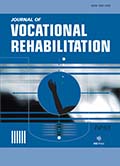Authors: Giesen, J. Martin | Hierholzer, Anne
Article Type:
Research Article
Abstract:
BACKGROUND: A considerable proportion of Vocational Rehabilitation (VR) consumers with visual impairments are Social Security Disability Insurance (SSDI) beneficiaries. The consumer and the effectiveness of VR and the Social Security Administration can benefit from greater understanding of the processes leading to improved employment outcomes for this population. OBJECTIVE: Our purpose was to investigate service patterns and evaluate the impact of VR services on competitive employment outcomes for consumers with visual impairments who also are SSDI beneficiaries. METHODS: Using FY 2011 RSA-911 data on 3,610 consumers who received SSDI, closed after receiving services, we conducted descriptive, factor
…analytic, and multilevel analyses to determine service patterns and what services predicted competitive employment. RESULTS: We found service groupings related to special and remedial services, job-related services, evaluation, and training and supports. Job placement, job search, on-the-job supports, on-the-job training, counseling and guidance, rehabilitation technology, other services, and maintenance were positively related to competitive employment, but reader services, interpreter services, job readiness training, augmentative skills training, and assessment were negatively related to employment. CONCLUSIONS: Pattern groupings of services suggest a systematic, holistic approach in VR. A new perspective is needed when examining the service-outcome relationship. Services positively related to competitive employment can have direct, direct-assistive, or indirect effects. Services negatively related to employment can be viewed as risk indicators.
Show more
Keywords: Blind, visual impairment, services, competitive employment, vocational rehabilitation, SSDI, Social Security Disability Insurance
DOI: 10.3233/JVR-150789
Citation: Journal of Vocational Rehabilitation,
vol. 44, no. 2, pp. 175-189, 2016
Price: EUR 27.50





